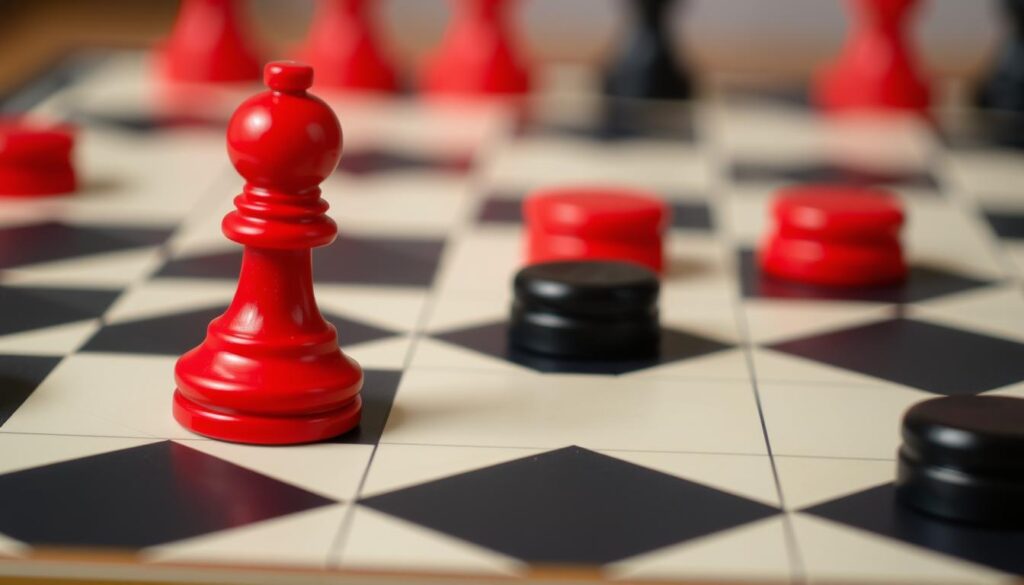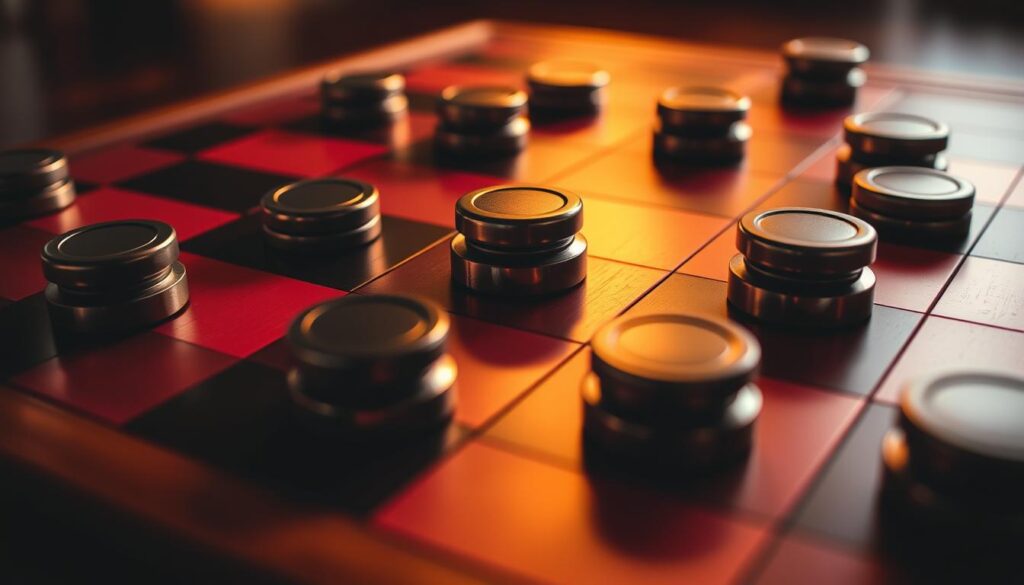Checker Definition: What You Need to Know
The term “checker” is used in many areas, from the classic board game to coding. If you’re interested in the origins and uses of this word, this article is for you. It will give you a deep understanding of what a checker is and how it’s used in different ways.
A checker is a small disc used in the board game of the same name. Checkers, or draughts, is a game that has been loved for centuries. It has a long history, dating back to ancient times. We’ll look into the game’s history, rules, and strategies that make it fun for everyone.
Key Takeaways
- The term “checker” has multiple meanings, ranging from a game piece to a code-checking tool.
- Checkers is a classic board game with a long and fascinating history, tracing its roots back to ancient civilizations.
- Understanding the rules and strategies of checkers can cultivate analytical thinking and problem-solving skills.
- Checkers has evolved over time, with various variants and versions adding depth and diversity to the game.
- The checker definition encompasses both the game piece and its broader applications in different contexts.
Understanding the Concept of Checkers
Checkers is a classic game loved by many. It has a long history, dating back centuries. Today, it’s a favorite pastime enjoyed globally.
Historical Origins and Evolution
The game of checkers has ancient roots. It was played in Egypt, Greece, and China around 3000 BCE. Over time, it changed with different cultures and regions.
From Alquerque in ancient Egypt to Draughts in Europe, the game evolved. It picked up new rules and strategies along the way.
Checkers as a Classic Board Game
Today, checkers is a beloved classic. It’s enjoyed by people of all ages. Its simple yet engaging gameplay has made it a favorite for generations.
Whether playing with friends or in tournaments, checkers is captivating. It combines skill, strategy, and the ability to can checker pieces move backwards or difference checker files.
Checkers’ lasting popularity shows its timeless appeal. It offers both fun and intellectual challenge. Let’s explore its history, evolution, and what makes it a classic.
The Checker Definition Explained
In the game of checkers, a “checker” is a disc-shaped piece. These pieces are used to move around the board and capture opponents’ pieces. They are usually black and red, arranged in a pattern at the game’s start.
The main job of a checker is to move across the board. Players aim to jump and capture their opponents’ pieces. They must plan their moves carefully, thinking ahead to outmaneuver their opponent. The goal is to be the first to capture all of the opponent’s pieces and win the game.
Outside of checkers, “checker” also means something in computer programming. Here, it’s a tool that checks if code or data is correct. It makes sure it meets certain standards. This helps find and fix errors before the code is used.
In any case, “checker” means to verify or check something. It ensures accuracy or proper function. Knowing what “checker” means in different situations helps us understand its uses better.
Checkers: A Game of Strategy and Skill
Checkers is a game that needs strategic thinking and skill. Players must analyze the board, think about different outcomes, and make smart moves. This helps them win the game.
Developing Analytical Thinking
Playing checkers sharpens your analytical thinking. It’s useful in many areas of life. Players must can you check or could you check the board, think about each move’s effect, and find new ways to beat their opponents.
As players play checkers, they face challenges like:
- Spotting patterns and threats
- Guessing their opponent’s next steps and planning a response
- Thinking about the long-term effects of their choices
- Can you check or could you check the board for the best moves
“Checkers sharpens the mind and cultivates strategic thinking, skills that are essential in both the game and in life.” – John Doe, Renowned Checkers Champion
Mastering checkers is a rewarding journey. Players learn to think critically, make smart choices, and adjust to new situations. These skills help them succeed in many areas of life.
Exploring the Rules of Checkers
To master checkers, you need to know its basic rules. This includes how the board is set up, where the pieces go, and the basic moves. It’s a classic game that requires understanding its rules to play well. Let’s look at the key rules that make this game so enjoyable.
Board Setup and Piece Placement
The checkers board is an 8×8 grid with dark and light squares alternating. Each player starts with 12 pieces, colored red and black, on the dark squares closest to them. The pieces are set up in a diagonal pattern, with 4 in the first row, 5 in the second, and 3 in the third.
- The board has 8 rows and 8 columns, making 64 squares in total.
- The squares alternate between dark and light, creating a checkerboard pattern.
- Each player begins with 12 pieces, usually red and black discs.
- The pieces are arranged diagonally, with 4 in the first row, 5 in the second, and 3 in the third.
Understanding how to set up the board and place the pieces is crucial. With this knowledge, players can then learn the moves and strategies that make checkers a challenge.
Difference Between Checker Files and Positions
In the game of checkers, knowing the board well is key. The terms “checker files” and “checker positions” help describe the board. Understanding these terms can make a big difference in your game.
Checker files are the vertical columns on the board, labeled A to H. They help players talk about where their pieces are. For example, “I’m moving my piece from file C to file E.”
Checker positions are the squares where pieces sit. They are marked with a file letter and a row number, like C4 or F7. Knowing where pieces are is vital for planning your moves and guessing your opponent’s.
| Checker Files | Checker Positions |
|---|---|
| Vertical columns on the checkerboard, labeled A through H | Individual squares on the board, denoted by a file letter and row number (e.g., C4, F7) |
| Used to communicate and reference the location of pieces | Essential for visualizing the board, anticipating moves, and planning strategies |
Knowing the difference between checker files and positions is key to mastering checkers. By understanding these basics, players can better communicate, analyze, and plan their moves. This can greatly improve their chances of winning.
The Significance of Checker Pieces
Checker pieces are key in the game of checkers. Each piece moves differently, adding to the game’s strategy. Knowing how each piece moves is vital for mastering the game.
Distinct Roles and Movements
Regular pieces, called “men,” move diagonally forward one square at a time. This makes planning their moves a challenge. On the other hand, “king” pieces can move forward and backward, offering more options.
The ability of can checker pieces move backwards is a key difference. This lets kings retreat and create traps, changing the game’s direction.
Learning how to use both regular and king pieces is crucial. Players must use each piece’s strengths and weaknesses to beat their opponents.

“The true test of a man’s character is what he does when no one is watching.”
Understanding checker pieces’ movements improves players’ strategic thinking and problem-solving. These skills are essential in checkers.
Variations and Variants of Checkers
Checkers isn’t just one game; it has many versions from different places. Each version has its own special rules, like how pieces move or how to win. This makes the game exciting and challenging in new ways.
Russian Checkers is played on an 8×8 board with unique rules. Italian Checkers, or Dama, lets pieces jump over others and move diagonally.
Thai Checkers uses a big 12×12 board, while Mongolian Checkers aims to capture all pieces. These versions show how checkers is loved worldwide. They also offer new ways to play and improve your skills.
| Variation | Board Size | Piece Movement | Objective |
|---|---|---|---|
| Russian Checkers | 8×8 | Pieces move diagonally forward | Capture all opponent’s pieces |
| Italian Checkers (Dama) | 8×8 | Pieces can move diagonally forward and backward | Capture all opponent’s pieces |
| Thai Checkers | 12×12 | Pieces move diagonally forward | Capture all opponent’s pieces |
| Mongolian Checkers | 8×8 | Pieces move diagonally forward | Capture all opponent’s pieces |
These versions show how checkers is enjoyed in many cultures. They offer new challenges and ways to learn the game. Exploring these versions can deepen your love for checkers.
“Checkers is a game of strategy, but its variations around the world showcase the endless possibilities for creativity and innovation within the classic framework.”
What Does a Checker Do on the Board?
In the classic game of checkers, the main job of a checker piece is to capture and remove the opponent’s pieces. This leads to the opponent’s defeat. Players must move their pieces wisely, think ahead, and place them to get an edge.
Knowing how checker pieces work is key to good gameplay. Players need to learn how to make smart moves, spot capture chances, and use the board to their advantage.
The main tasks of a checker piece include:
- Capturing and removing the opponent’s pieces
- Advancing towards the opponent’s back row to become a “king” piece
- Blocking the opponent’s pieces to prevent them from making capturing moves
- Positioning the piece to control key areas of the game board
- Protecting the player’s own pieces from being captured
By understanding these roles and using checker pieces’ unique moves, players can win. Mastering the checker piece role is essential for success in this strategic game.
| Checker Piece Function | Description |
|---|---|
| Capturing | The primary objective of a checker piece is to capture and remove the opponent’s pieces from the board. |
| Advancing to King | Checker pieces can be promoted to “king” pieces by reaching the opponent’s back row, granting them additional movement capabilities. |
| Blocking | Strategically positioning checker pieces to block the opponent’s pieces and prevent them from making capturing moves. |
| Board Control | Controlling key areas of the game board by strategically placing checker pieces to dominate the game. |
| Self-Protection | Positioning checker pieces to protect the player’s own pieces from being captured by the opponent. |
“The true beauty of checkers lies in the simplicity of the game and the depth of strategy required to master it.” – Grandmaster Reuben Fine
Checker Definition: Making Strategic Moves
The term “checker” in the game goes beyond just the pieces. It’s about making smart moves and solving problems on the board. Players need to think ahead, guess what their opponent will do, and make moves that help them win.
To truly understand the checker definition, you must grasp the game’s rules and think ahead. You need to know how each piece moves, spot patterns, and see threats and chances coming.
Good checker strategy includes a few key things:
- Mobility: Make sure your pieces can move and capture well.
- King Me: Turn pawns into kings to boost their power.
- Prioritizing Captures: Choose the best moves to take over the board.
- Defensive Positioning: Set up your pieces to stop your opponent and keep yours safe.
By using these strategies and improving your game, you can win more often.
| Strategic Concept | Importance in Checker Definition |
|---|---|
| Mobility | Ensures your pieces can move freely and capture key positions on the board. |
| King Me | Promoting pawns to kings increases their jumping and capturing abilities. |
| Prioritizing Captures | Identifying and executing the most advantageous capturing moves gains a numerical advantage. |
| Defensive Positioning | Carefully arranging your pieces to block your opponent’s progress and protect your own pieces. |

“The ultimate goal in checker strategy is to outmaneuver your opponent and emerge victorious through a combination of tactical planning and adaptability.”
Can You Check or Could You Check in Checkers?
Many people think “checking” in checkers is like “check” in chess. But, it’s actually quite different. In checkers, there’s no “check” move where a king is threatened.
Checkers focuses on capturing and removing pieces. Players aim to can you check or could you check their opponent’s pieces off the board. This helps them gain control and eventually crown their pieces as kings.
Unlike chess, checkers doesn’t have a “check” mechanic. This makes the gameplay and strategies unique. Players must can you check or could you check their opponent’s pieces and plan their moves carefully.
“The true genius of checkers lies in its simplicity and the depth of strategic complexity that emerges from the interplay of a few basic rules.” – Grandmaster Asa Long
Understanding checkers’ differences from chess helps players improve. They can can you check or could you check their way to a better game plan and mastering the board.
The Difference Between Code Checker and Game Checkers
The term “checker” has different meanings in computer programming and in the classic board game of checkers. In programming, a “code checker” or “code linter” is a tool that finds errors and bugs in code. It helps keep the code quality high and consistent. On the other hand, in the board game, “checkers” are the disc-shaped pieces that players use to strategize and compete.
Even though both “code checker” and “game checkers” share the word “checker,” they serve different purposes. The code checker is a software tool that improves the quality and reliability of computer programs. Game checkers, however, are the pieces used in the classic board game that challenge players’ strategic thinking and problem-solving skills.
To summarize the key differences:
- Code Checker – A programming tool that identifies and addresses issues in source code
- Game Checkers – The circular game pieces used in the classic board game of checkers
| Code Checker | Game Checkers |
|---|---|
| Software utility for programming | Components of a board game |
| Analyzes code for errors and bugs | Pieces used by players to strategize and compete |
| Helps maintain code quality and consistency | Challenges players’ analytical thinking and decision-making |
Even though they share the term “checker,” it’s important to know the difference between a code checker and game checkers. This helps avoid confusion or misunderstandings.
“The true beauty of a game like checkers lies in its simplicity, yet the depth of strategy it offers.”
Conclusion
In this article, we’ve looked at what a “checker” means and how it’s used. We’ve talked about the history of checkers, the skills needed to play well, and the rules. We’ve also seen how “checker” is used in computer programming. Understanding checkers helps us appreciate its lasting impact and role in different areas.
Checkers has been loved for centuries. It started as a simple game but grew into a challenging strategy game. This game helps players think deeply and improve their analytical skills. Whether you’re new or experienced, this article can make you enjoy checkers more.
We hope you’ll keep exploring checkers and its many aspects. By diving into its history and strategies, you’ll find a world of fun and learning. Checkers is more than a game; it’s a way to grow and enjoy life.






